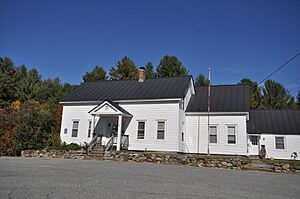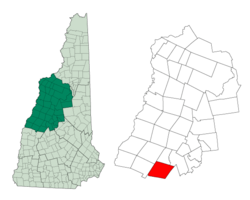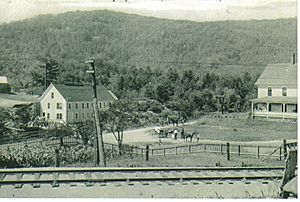Grafton, New Hampshire facts for kids
Quick facts for kids
Grafton, New Hampshire
|
||
|---|---|---|
|
Town
|
||

Town hall
|
||
|
||

Location in Grafton County, New Hampshire
|
||
| Country | United States | |
| State | New Hampshire | |
| County | Grafton | |
| Incorporated | 1778 | |
| Villages |
|
|
| Area | ||
| • Total | 42.4 sq mi (109.8 km2) | |
| • Land | 41.5 sq mi (107.4 km2) | |
| • Water | 0.9 sq mi (2.4 km2) 2.20% | |
| Elevation | 870 ft (270 m) | |
| Population
(2020)
|
||
| • Total | 1,385 | |
| • Density | 33/sq mi (12.9/km2) | |
| Time zone | UTC-5 (Eastern) | |
| • Summer (DST) | UTC-4 (Eastern) | |
| ZIP code |
03240
|
|
| Area code(s) | 603 | |
| FIPS code | 33-30820 | |
| GNIS feature ID | 0873609 | |
Grafton is a small town in Grafton County, New Hampshire, United States. In 2020, about 1,385 people lived there. It is known for its natural beauty and a unique period in its recent history.
Contents
History of Grafton
Grafton was first given land in 1761 and then again in 1769. It was named after Augustus FitzRoy, the 3rd Duke of Grafton. He was related to Benning Wentworth, who was a governor back then. Grafton officially became a town in 1778.
For a long time, Grafton's economy relied on farming to feed families. It also had small businesses and mining. There were several mines for mica and quarries for granite. One of the most famous was Ruggles Mine.
Geography of the Town
Grafton covers about 42.6 square miles (109.8 square kilometers). Most of this area, about 41.7 square miles (107.4 square kilometers), is land. The rest, about 0.9 square miles (2.4 square kilometers), is water.
The highest point in Grafton is the top of Melvin Mountain. It stands about 2,177 feet (664 meters) above sea level. Grafton Pond is a notable body of water in the western part of the town. Most of Grafton's water flows into the Merrimack River. However, the western edge of town sends its water towards the Connecticut River.
Population Changes
| Historical population | |||
|---|---|---|---|
| Census | Pop. | %± | |
| 1790 | 403 | — | |
| 1800 | 682 | 69.2% | |
| 1810 | 931 | 36.5% | |
| 1820 | 1,094 | 17.5% | |
| 1830 | 1,207 | 10.3% | |
| 1840 | 1,201 | −0.5% | |
| 1850 | 1,259 | 4.8% | |
| 1860 | 1,150 | −8.7% | |
| 1870 | 907 | −21.1% | |
| 1880 | 934 | 3.0% | |
| 1890 | 787 | −15.7% | |
| 1900 | 748 | −5.0% | |
| 1910 | 641 | −14.3% | |
| 1920 | 554 | −13.6% | |
| 1930 | 539 | −2.7% | |
| 1940 | 552 | 2.4% | |
| 1950 | 442 | −19.9% | |
| 1960 | 348 | −21.3% | |
| 1970 | 370 | 6.3% | |
| 1980 | 739 | 99.7% | |
| 1990 | 923 | 24.9% | |
| 2000 | 1,138 | 23.3% | |
| 2010 | 1,340 | 17.8% | |
| 2020 | 1,385 | 3.4% | |
| U.S. Decennial Census | |||
In 2010, Grafton had 1,340 people living in 564 households. The town's population has changed a lot over the years. For example, in 1790, there were only 403 people. The population grew steadily until the mid-1800s, then it decreased for many years.
Since the 1960s, Grafton's population has been growing again. By 2020, it reached 1,385 people. The average age of people in Grafton in 2010 was about 45.6 years old.
The Free Town Project
Around 2004, Grafton became a special place for a group called Libertarians. They started something called the Free Town Project. Their goal was to encourage people who believed in less government rules to move to Grafton.
Grafton was appealing to them because it did not have many building rules (called zoning laws). It also had low property taxes at the time. A local Libertarian, John Babiarz, invited people to move there.
About 200 new people moved to Grafton, mostly men. The new residents voted for changes, including cutting the town's budget by 30%. This led to some challenges for the town. For example, town offices were not heated in winter, and roads had many potholes. The police department also had very few officers.
Another issue that came up was about black bears. Some new residents did not use special trash cans that bears cannot open. They also did not always dispose of waste safely. This led to more bears coming into town, sometimes even entering homes. Some bears became very bold, causing problems for residents.

The Free Town Project ended in 2016.
Notable People
- Monroe Heath (1827–1894), he was the mayor of Chicago from 1876 to 1879.
- Myra Belle Martin (1861–1936), a teacher, writer, and financier in the late 1800s and early 1900s.
- Cyrus A. Sulloway (1839–1917), he was a congressman.
Places to Visit
- Ruggles Mine (This mine is now closed to visitors.)
See also
 In Spanish: Grafton (Nuevo Hampshire) para niños
In Spanish: Grafton (Nuevo Hampshire) para niños



